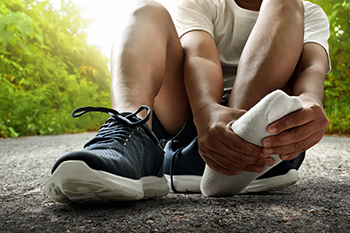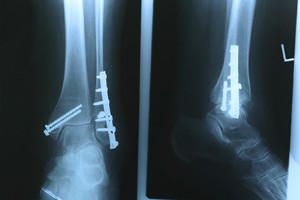
Running is a fantastic way to stay fit, boost cardiovascular health, and enjoy the great outdoors. Despite its many benefits, running can also take a toll on your feet and ankles. More than 80 percent of running injuries are attributed to repetitive stress, making it important for runners to be aware of the potential pitfalls and methods to prevent and address them. The repetitive impact of every foot strike during your runs can put significant stress on your muscles, joints, and connective tissues, increasing the risk of injury. Foot injuries are a significant concern for runners. Plantar fasciitis, metatarsalgia, and stress fractures are some of the more common conditions that can affect the feet. These injuries can cause intense pain, particularly during the push off phase of running. Ankles are susceptible to sprains, strains, and ligament injuries in runners. Running on uneven terrain and wearing improper footwear can contribute to these injuries, which may result in instability and limited mobility. If you experience pain or discomfort in the feet or ankles from your running, it is suggested that you make an appointment with a podiatrist for an exam, diagnosis, and tips for preventing injuries.
Exercising your feet regularly with the proper foot wear is a great way to prevent injuries. If you have any concerns about your feet, contact Howard Waxman, DPM of Pleasant Valley Podiatry. Our doctor will treat your foot and ankle needs.
How to Prevent Running Injuries
Many common running injuries are caused by overuse and overtraining. When the back of the kneecap starts wearing out and starts causing pain in your knee, this is commonly referred to as runner’s knee. Runner’s knee is a decrease in strength in your quadriceps and can occur if you’re not wearing properly fitted or supporting shoes. To prevent runner’s knee, focusing on hip strengthening is a good idea, as well as strengthening your quads to keep the kneecaps aligned.
What Are Some Causes of Running Injuries?
- One cause of a common running injury is called iliotibial band syndrome.
- Plantar fasciitis is also another common injury.
- Stress fractures can occur from overtraining, lack of calcium, or even your running style.
Best Ways to Prevent Running Injuries
- Wear footwear that fits properly and suits your running needs.
- Running shoes are the only protective gear that runners have to safeguard them from injury.
- Make a training schedule. Adding strengthening exercises as well as regular stretching can help keep you strong and limber and can lessen the possibility of injuries.
- Stretching keeps muscles limber; this will help you gain better flexibility.
If you have any questions please feel free to contact one of our offices located in Willoughby Hills and Broadview Heights, OH . We offer the newest diagnostic and treatment technologies for all your foot and ankle needs.

As we age, it is helpful for our homes to be a sanctuary of comfort and safety. For the elderly, preventing falls is paramount to maintaining independence and overall well-being. Simple yet effective home preparations can make a world of difference. This can begin by decluttering living spaces and removing tripping hazards like loose rugs or cords. Install handrails and grab bars in bathrooms and along staircases to provide stability. Adequate lighting is important, ensuring that every corner is well-lit, regardless of day or night. Non-slip mats in the bathroom and a shower chair can reduce the risk of slips and falls during bathing. Regular maintenance is essential, so fix unstable floorboards, uneven tiles, or loose handrails promptly. Falling can seriously affect the feet, and may lead to difficulty in accomplishing daily activities. If you would like more information about how to protect your elderly loved ones from falling in the household, it is suggested that you confer with a podiatrist who can offer you additional effective fall-prevention tips.
Preventing falls among the elderly is very important. If you are older and have fallen or fear that you are prone to falling, consult with Howard Waxman, DPM from Pleasant Valley Podiatry. Our doctor will assess your condition and provide you with quality advice and care.
Every 11 seconds, an elderly American is being treated in an emergency room for a fall related injury. Falls are the leading cause of head and hip injuries for those 65 and older. Due to decreases in strength, balance, senses, and lack of awareness, elderly persons are very susceptible to falling. Thankfully, there are a number of things older persons can do to prevent falls.
How to Prevent Falls
Some effective methods that older persons can do to prevent falls include:
Falling can be a traumatic and embarrassing experience for elderly persons; this can make them less willing to leave the house, and less willing to talk to someone about their fears of falling. Doing such things, however, will increase the likelihood of tripping or losing one’s balance. Knowing the causes of falling and how to prevent them is the best way to mitigate the risk of serious injury.
If you have any questions, please feel free to contact one of our offices located in Willoughby Hills and Broadview Heights, OH . We offer the newest diagnostic and treatment technologies for all your foot care needs.

A broken toe can be a painful and inconvenient injury, but with proper care, you can help it heal more quickly and minimize discomfort. First and foremost, it is essential to rest and protect the injured toe. This means avoiding putting weight on it and wearing comfortable, supportive footwear. Swelling and pain can be reduced by elevating the foot whenever possible, and taking over-the-counter pain relievers may provide some relief. In some cases, a splint or buddy taping the broken toe to its neighbor toe can aid in stabilization. Be mindful of any signs of infection, such as increased pain, redness, or discharge, and seek medical attention promptly if you notice these symptoms. Patience is key when caring for a broken toe, as it may take several weeks to fully heal. If you have broken your toe, it is suggested that you contact a podiatrist who can accurately diagnose this condition, and guide you toward the treatment that is right for you.
Broken toes may cause a lot of pain and should be treated as soon as possible. If you have any concerns about your feet, contact Howard Waxman, DPM from Pleasant Valley Podiatry. Our doctor will treat your foot and ankle needs.
What Is a Broken Toe?
A broken toe occurs when one or more of the toe bones of the foot are broken after an injury. Injuries such as stubbing your toe or dropping a heavy object on it may cause a toe fracture.
Symptoms of a Broken Toe
Although the injured toe should be monitored daily, it is especially important to have a podiatrist look at your toe if you have severe symptoms. Some of these symptoms include worsening or new pain that is not relieved with medication, sores, redness, or open wounds near the toe.
If you have any questions, please feel free to contact one of our offices located in Willoughby Hills and Broadview Heights, OH . We offer the newest diagnostic and treatment technologies for all your foot care needs.

Choosing the right footwear is essential for physical activity, including walking or running. While the two may seem similar, they entail different biomechanics and therefore require distinct types of shoes. Walking shoes are designed for forward motion and primarily provide cushioning in the heel and support for the arch. They tend to be more flexible to accommodate the natural rolling motion of the foot as you walk. The emphasis is on comfort and stability, making them ideal for daily strolls or leisurely walks. Running shoes, on the other hand, are engineered to handle the repeated impact of the foot striking the ground with greater force during a run. They offer more cushioning throughout the entire sole, a stiffer midsole to support the arch, and added stability to control pronation. Running shoes are essential for absorbing shock and preventing injuries during high impact activities like jogging or sprinting. Wearing the right shoes for your chosen activity can enhance performance, reduce the risk of injury, and ensure a more comfortable experience. If you would like additional facts about walking and running shoe differences, it is suggested that you speak with a podiatrist.
For more information about walking shoes versus running shoes, consult with Howard Waxman, DPM from Pleasant Valley Podiatry. Our doctor can measure your feet to determine what your needs are and help you find an appropriate pair of footwear.
Foot Health: The Differences between Walking & Running Shoes
There are great ways to stay in shape: running and walking are two great exercises to a healthy lifestyle. It is important to know that running shoes and walking shoes are not interchangeable. There is a key difference on how the feet hit the ground when someone is running or walking. This is why one should be aware that a shoe is designed differently for each activity.
You may be asking yourself what the real differences are between walking and running shoes and the answers may shock you.
Differences
Walking doesn’t involve as much stress or impact on the feet as running does. However, this doesn’t mean that you should be any less prepared. When you’re walking, you land on your heels and have your foot roll forward. This rolling motion requires additional support to the feet.
Flexibility – Walking shoes are designed to have soft, flexible soles. This allows the walker to push off easily with each step.
If you have any questions, please feel free to contact one of our offices located in Willoughby Hills and Broadview Heights, OH . We offer the newest diagnostic and treatment technologies for all your foot care needs.

A fractured ankle involves an injury to one or more of the three bones that make up the ankle joint, the tibia, fibula, and talus, as well as the surrounding ligaments. Such fractures can result from various causes, including accidents, falls, heavy impacts, or sports injuries. Signs of a fractured ankle consist of pain, deformity, swelling, bruising, and difficulty walking. The typical healing time for an ankle fracture varies depending on the severity of the fracture. Non-surgical fractures take approximately 6 to 12 weeks, while surgical fractures take longer. Podiatrists can diagnose and manage these injuries, provide orthotic support, and recommend rehabilitation exercises. Early medical attention is crucial, and first aid measures such as elevation and wound care can be helpful while awaiting medical care. Preventing ankle fractures involves properly warming up and wearing appropriate footwear. Additionally, it is beneficial to avoid uneven surfaces. Fractured ankles can have serious consequences if not treated properly, leading to complications, including mobility issues, chronic pain, and arthritis. If you believe you have fractured your ankle, it is suggested that you make an appointment with a podiatrist as quickly as possible.
Ankle pain can have many different causes and the pain may potentially be serious. If you have ankle pain, consult with Howard Waxman, DPM from Pleasant Valley Podiatry. Our doctor will assess your condition and provide you with quality foot and ankle treatment.
Ankle pain is any condition that causes pain in the ankle. Due to the fact that the ankle consists of tendons, muscles, bones, and ligaments, ankle pain can come from a number of different conditions.
Causes
The most common causes of ankle pain include:
Symptoms
Symptoms of ankle injury vary based upon the condition. Pain may include general pain and discomfort, swelling, aching, redness, bruising, burning or stabbing sensations, and/or loss of sensation.
Diagnosis
Due to the wide variety of potential causes of ankle pain, podiatrists will utilize a number of different methods to properly diagnose ankle pain. This can include asking for personal and family medical histories and of any recent injuries. Further diagnosis may include sensation tests, a physical examination, and potentially x-rays or other imaging tests.
Treatment
Just as the range of causes varies widely, so do treatments. Some more common treatments are rest, ice packs, keeping pressure off the foot, orthotics and braces, medication for inflammation and pain, and surgery.
If you have any questions, please feel free to contact one of our offices located in Willoughby Hills and Broadview Heights, OH . We offer the newest diagnostic and treatment technologies for all your foot care needs.